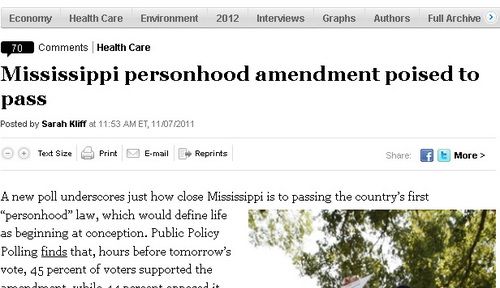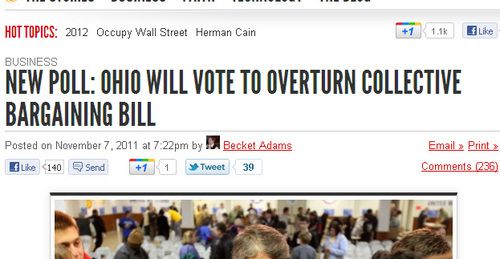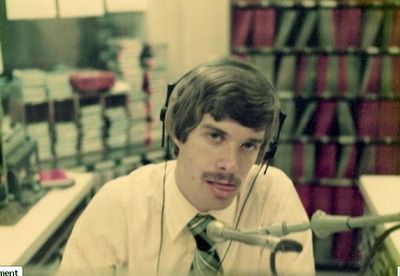A big polling ‘miss,’ Rushford gets out of the booze business, dog dog goose, duck and cover 2011, and a look at a classic prank.
1) DEWEY DEFEATS MISSISSIPPI
As political stories go, yesterday morning’s headline in the Washington Post wasn’t “Dewey Defeats Truman,” but it was yet another misfire that should have the media questioning itself again on its use of its favorite crutch — polls.
The Washington Post treated a poll on Mississippi’s “personhood amendment” — it would have banned abortion and access to contraception — as a fait accompli yesterday, before anyone had cast a single vote.
Let’s see how that turned out…
Whoops. It not only lost. It lost big. The polls were wrong, as the polls quite often are.
The firm — the Democrat-leaning Public Policy Polling — got one right. In Ohio, The Blaze’s headline used it to declare the winner yesterday morning:
Thirty-nine percent of Ohioans voted against the bill that repealed the collective bargaining rollback, just within the poll’s original margin of error.
Polls are — when all the talk of science is stripped away — a crapshoot. People lie to pollsters, polls are often weighted incorrectly, and news organizations use them as predictors. You’d think we’d learn.
One takeaway from last night’s election: The era of globs of numbers on radio, TV, and newspapers on election night is over. Twitter, and in our region, MPR News’ Tom Weber, sparkled, at using it to relay school levy information from around the state. Sitting in the comfort of my home 1,200 miles away, it took me only seconds to follow a mayoral election in my hometown as each precinct came in, far beyond the traditional capability of newspapers, TV, and radio.
The game has changed for good.
2) NO CITY BOOZE IN RUSHFORD
Rushford voters decided yesterday that their city shouldn’t be in the liquor business, the Winona Daily News reports. Fifty-six percent of the voters decided to keep the store closed. The original building was destroyed in the 2007 flood. One hiccup: The city will have to pay $800,000 back to FEMA. Flood relief funds were used to rebuild the store, which lost more money in 2009 than all but two municipal liquor stores in Minnesota.
3) DOG, DOG, GOOSE!
The Taiwanese animation outfit, NMA, is tackling the botched WCCO story in which a reporter mistakenly asserted that the owner of a puppy mill was sending dogs to New York to be sold as meat.
4) DUCK AND COVER 2011
If you’re an old-time radio broadcaster — bowing — you probably learned long ago that the Emergency Broadcast System was mostly for show — to give people the illusion of a place to turn in the event of a nuclear attack. The foundation of the system was that if the nukes were heading our way, young disc jockeys — bowing — making $110 a week would stay in the studio, rip open the bright pink envelope, “authenticate” the message, and stop playing Tie a Yellow Ribbon long enough to patch in the president.
I speak for all old disc jockeys with a disdain for Tony Orlando and Dawn: We were prepared to push old ladies out of the way to get into the bomb shelter first (we actually had one at our radio station — courtesy of the government — although nobody knew where the key was and we think it was filled with water). The last sound you would have heard before the nuclear blast, was the sound of a needle at the end of a 45 RPM record. That’s the flaw with the system, the 2011 version of which will be “tested” today.
At 1 p.m., every electronic form of communication (licensed by the government in some way) will participate, according to FEMA:
FEMA, the FCC, and NOAA’s vision for improving the EAS is incremental, which means testing the readiness and effectiveness of the EAS as it currently exists today is the first step. A more effective and functional EAS requires continual testing to identify necessary improvements so that all levels of the system can better serve our communities and deliver critical information that will save lives and property.
EAS Participants provide a critical public service to the nation as the resilient backbone of alert and warning when all other means of communication are unavailable. EAS Participants include all broadcasters, satellite and digital radio and television, cable television and wireline video providers who ensure the system is at a constant state of readiness.
It’s a little different now. The human link has been replaced (mostly) and the key component of the system is the uber-dependability of our electronic utilities.
FEMA has set up an online forum to discuss this system (you could spend hours browsing the messages). Here’s one message from the front line that shows the problem:
As you know, Western Massachusetts experienced an extreme snow event last week which put power out to almost all of Western Mass. and Connecticut. All of the “what to do in an emergency” manuals said keep a battery operated radio and wait for announcements. Well, with the power out, we all waited (in the dark) for announcements…there were NONE! Not even one radio station in Western Mass was broadcasting information or even call-in shows. When the power came on for some of the lucky ones, all of the “what to do’s” were on the TV! This seems a little short sighted and I haven’t seen any forums to voice concerns. We couldn’t charge cell phones or laptops, so what was the point of broadcasting on TV? All of the town mayors were getting their “face” time on TV, but we couldn’t see them! No one knew where the shelters were located or where help might be available if people were in trouble. All of this information was available through computers and TV.
5) MAILBAG: PRANKS
Meighan Byron of St. Louis Park wrote to say yesterday’s Best Buy video (here) reminded her of a prank in Austin, Minnesota in 2006.
The kids streaming across the crosswalk were using an underground tunnel to scamper back and cross the street again.
Bonus: Today’s moment of (northern) Minnesota zen:
TODAY’S QUESTION
An appeals court on Tuesday upheld the constitutionality of the federal health care law due to take effect in 2014. The court found that the government could require Americans to buy health insurance, holding that “the right to be free from federal regulation is not absolute.” Today’s Question: What parts of your life do you think should be free of government regulation?
The Big Story Blog will report results and provide analysis of school levy votes and other ballot questions across Minnesota.
WHAT WE’RE DOING
Midmorning (9-11 a.m.) – First hour: Is Obama disappointing his green base? And how will environmentalists make themselves heard in the 2012 elections?
Second hour: Should people be screened for prostate cancer?
Midday (11 a.m. – 1 p.m.) – First hour: Midday’s series on the GOP presidential candidates continues. This hour: Herman Cain. Guest is Washington University political scientist Steven Smith.
Second hour: Tom Brokaw, who spoke Tuesday at the Westminster Town Hall Forum about his new book, “The Time of Our Lives: A Conversation About America.”
Talk of the Nation (1-3 p.m.) – First hour: Political talk with NPR politics editor Ken Rudin.
Second hour: After allegations of sexual abuse we often hear that witnesses and victims told people in charge what was going on. And, for any number of reasons, they didn’t do enough to stop it. Why we speak up. Or not.




